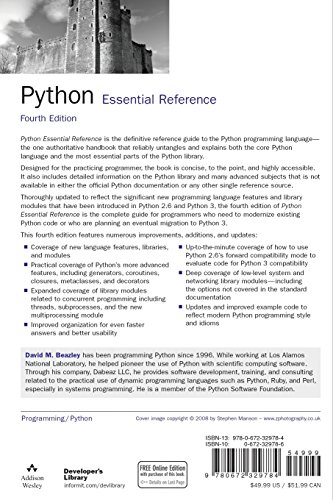
Price: $28.99
From the Publisher
Title
Effective Python Effective Python LiveLessons Python Essential Reference The Python Standard Library by Example Modern Python LiveLessons: Big Ideas and Little Code in Python
Author
Brett Slatkin Brett Slatkin David Beazley Doug Hellmann Raymond Hettinger
User Experience Level
Intermediate and advanced level Python programmers Intermediate and advanced level Python programmers Assumes that the reader has prior programming experience with Python or another language such as C or Java Intermediate-level Python programmers Intermediate-level Python programmers
What You Will Learn
How to harness Python’s full power to write exceptionally robust and well-performing code. The Pythonic way of writing programs, building on a fundamental understanding of Python to help you write programs more effectively. The core Python language, and the most essential parts of the Python library. How to utilize the Python 3.x library to jump-start application development. How to elegantly code powerful solutions succinctly and efficiently with Python.
Core Concept
Using the concise, scenario-driven style pioneered in Scott Meyers’ best-selling Effective C++, Brett Slatkin brings together 59 Python best practices, tips, and shortcuts, and explains them with realistic code examples. Hands-on demonstration of a broad but related set of items designed to provide concise and specific guidance on what to do and what to avoid when writing programs using Python. Accurate and concise reference to the most important parts of Python. Presents selected examples from the hundereds of modules in the Python standard linrary demonstrating how to use the most commonly used features of the modules that support Python’s ‘batteries included’ slogan. Provides developers with an approach to programming in Python that expresses big ideas succinctly, with the minimum of code, allowing the business logic to shine through.
Key Topics Covered
Best practices for writing functions that clarify intention, promote reuse, and avoid bugs; Expressing behaviors with classes and objects; Avoid pitfalls with metaclasses and dynamic attributes; Efficient approaches to concurrency and parallelism; Techniques and idioms for using Python’s built-in modules; Tools and best practices for collaborative development Methods; Comprehensions and generators; Functions and classes; Concurrency and parallelism; How to make programs more robust Language features, libraries, and modules; Generators, coroutines, closures, metaclasses, and decorators; How to use Python 2.6’s forward compatibility mode to evaluate code for Python 3 compatibility; Low-level system and networking library modules Python 3.x’s new libraries, significant functionality changes, and new layout and naming conventions. Expert porting guidance for moving code from 2.x Python standard library modules to their Python 3.x equivalents. Newer features from Python 3.6, including f-strings and type hinting; ETL (extract-transform-load) techniques to prepare real-world data for analysis; How to improve code reliability
Python Versions Covered
3.x and 2.x Python 3 Python 2.6 and 3.0. Omits features of Python 2 that have been removed from Python 3. Does not features of Python 3 that have not been back-ported. Python 3 In an effort to maintain clear and concise descriptions for each example, the differences between Python 2 and 3 are not highlighted in each chapter. Python 3.6
Publisher : Addison-Wesley Professional; 4th edition (July 9, 2009)
Language : English
Paperback : 717 pages
ISBN-10 : 0672329786
ISBN-13 : 978-0672329784
Item Weight : 1.73 pounds
Dimensions : 5.9 x 1.1 x 8.9 inches
Price: $28.99




